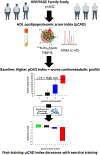Associations of an HDL apolipoproteomic index with cardiometabolic risk factors before and after exercise training in the HERITAGE Family Study
- PMID: 38823353
- PMCID: PMC11254543
- DOI: 10.1016/j.atherosclerosis.2024.117587
Associations of an HDL apolipoproteomic index with cardiometabolic risk factors before and after exercise training in the HERITAGE Family Study
Abstract
Background and aims: Previous studies have derived and validated an HDL apolipoproteomic score (pCAD) that predicts coronary artery disease (CAD) risk. However, the associations between pCAD and markers of cardiometabolic health in healthy adults are not known, nor are the effects of regular exercise on pCAD.
Methods: A total of 641 physically inactive adults free of cardiovascular disease from the HERITAGE Family Study completed 20 weeks of exercise training. The pCAD index (range 0-100) was calculated using measurements of apolipoproteins A-I, C-I, C-II, C-III, and C-IV from ApoA-I-tagged serum (higher index = higher CAD risk). The associations between pCAD index and cardiometabolic traits at baseline and their training responses were assessed with Spearman correlation and general linear models. A Bonferroni correction of p < 8.9 × 10-04 was used to determine statistical significance.
Results: The mean ± SD baseline pCAD index was 29 ± 32, with 106 (16.5 %) participants classified as high CAD risk. At baseline, pCAD index was positively associated with blood pressure, systemic inflammation, and body composition. HDL size, VO2max, and HDL-C were negatively associated with pCAD index at baseline. Of those classified as high CAD risk at baseline, 52 (49 %) were reclassified as normal risk after training. Following training, pCAD index changes were inversely correlated (p < 1.4 × 10-04) with changes in HDL-C, HDL size, and LDL size.
Conclusions: A higher pCAD index was associated with a worse cardiometabolic profile at baseline but improved with regular exercise. The results from this study highlight the potential role of HDL apolipoproteins as therapeutic targets for lifestyle interventions, particularly in high-risk individuals.
Keywords: Biomarker; Coronary artery disease; High-density lipoprotein; Proteomics; pCAD.
Copyright © 2024 Elsevier B.V. All rights reserved.
Conflict of interest statement
Declaration of competing interest The authors declare the following financial interests/personal relationships which may be considered as potential competing interests: Mark A. Sarzynski reports financial support was provided by National Institutes of Health. Robert E. Gerszten reports a relationship with National Institutes of Health that includes: funding grants. J. Sebastian Miranda Maravi reports a relationship with National Institutes of Health that includes: funding grants. Jacob L. Barber reports a relationship with National Institutes of Health that includes: funding grants. Ryan W. Pearce reports a relationship with Quest Diagnostics that includes: employment and equity or stocks. Michael J. McPhaul reports a relationship with Quest Diagnostics that includes: employment and equity or stocks. Timothy S. Collier reports a relationship with Quest Diagnostics that includes: employment and equity or stocks. Robert J. Konrad reports a relationship with Eli Lilly and Company that includes: employment and equity or stocks. The other authors declare that they have no known competing financial interests or personal relationships that could have appeared to influence the work reported in this paper.
Figures


Similar articles
-
Interaction between genetic risk score and dietary carbohydrate intake on high-density lipoprotein cholesterol levels: Findings from the study of obesity, nutrition, genes and social factors (SONGS).Clin Nutr ESPEN. 2025 Apr;66:83-92. doi: 10.1016/j.clnesp.2024.12.027. Epub 2025 Jan 10. Clin Nutr ESPEN. 2025. PMID: 39800136
-
High-Density Lipoprotein Particle Concentration and Size Predict Incident Coronary Artery Disease Events in a Cohort With Type 1 Diabetes.J Am Heart Assoc. 2024 Jul 16;13(14):e034763. doi: 10.1161/JAHA.123.034763. Epub 2024 Jul 3. J Am Heart Assoc. 2024. PMID: 38958152 Free PMC article.
-
Assessing Serum Apolipoproteins A-I and b100 and the Apo A-I/Apo b100 Ratio in Relation to Premature Coronary Artery Disease and Its Severity.Catheter Cardiovasc Interv. 2025 Jul;106(1):153-162. doi: 10.1002/ccd.31497. Epub 2025 Apr 8. Catheter Cardiovasc Interv. 2025. PMID: 40200668
-
Interventions for promoting habitual exercise in people living with and beyond cancer.Cochrane Database Syst Rev. 2018 Sep 19;9(9):CD010192. doi: 10.1002/14651858.CD010192.pub3. Cochrane Database Syst Rev. 2018. PMID: 30229557 Free PMC article.
-
Falls prevention interventions for community-dwelling older adults: systematic review and meta-analysis of benefits, harms, and patient values and preferences.Syst Rev. 2024 Nov 26;13(1):289. doi: 10.1186/s13643-024-02681-3. Syst Rev. 2024. PMID: 39593159 Free PMC article.
References
-
- Toth PP, Barter PJ, Rosenson RS, Boden WE, Chapman MJ, Cuchel M, et al. High-density lipoproteins: A consensus statement from the national lipid association. J Clin Lipidol. 2013;7:484–525 - PubMed
-
- Kontush A. Hdl-mediated mechanisms of protection in cardiovascular disease. Cardiovasc Res. 2014;103:341–349 - PubMed
-
- Annema W, von Eckardstein A. High-density lipoproteins. Multifunctional but vulnerable protections from atherosclerosis. Circ J. 2013;77:2432–2448 - PubMed
Publication types
MeSH terms
Substances
Grants and funding
LinkOut - more resources
Full Text Sources
Medical
Miscellaneous

